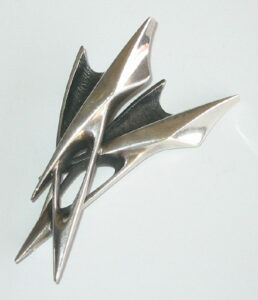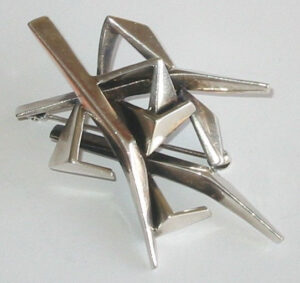
Table of Contents
ToggleØivind Modahl (1916-1981)
In the 1950s there was a trend in jewelry production towards independent artists making unique pieces of jewelry, the Jewelry Studio movement. Øivind Modahl was pionering this movement in Norway when he opend his workshop in Oslo in 1953. The trend continued with amongst others Uni David-Andersen and Studio Else & Paul in the late 50s, and later Tone Vigeland and Toril Bjorg in the 60s.
The Modahl name is well known to collectors of Norwegian jewelry, mainly because of the family company of Øivind Modahl’s father Einar Modahl, with a large production of enamelled silver jewelry. Øivind Modahl trained in his fathers factory/workshop before starting off on his own.

silver with rough uncut ruby.
Modahl’s production of handmade jewelry features a quite individualistic style. His interest in stones is closely connected with his jewelry production, also pionering the use of Norwegian semi prescious stones and raw chrystals in bold modernistic settings. The colors and structure of the stones are crucial for the setting. The results are harmonious sculptures of stone and metal. When in 1965 the talented gemmologist surprised his contemporaries by starting to use raw, unpolished stones, the idea was that natural minerals have a beauty that can not be improved by cutting or polishing. His jewelry features a wide range of minerals such as Amethysts, Rubies, Agates and Pyrite.
To explore and develop good shapes and settings for rings with stones, was one of Modahl’s specialities. In the urge to perfect the ringband and find shapes that would slip off and on easily, but would not turn on the finger, he tried both the super-ellipse, a form first developed by the Danish poet and designer Piet Hein, and the triangle. Both these forms make it possible to build a large form above the band and still maintain the balance of the ring on the finger. With his technique based on tension in the material that holds the stone, he managed to reach purity of line with settings almost invisible.
Although Øivind Modahl is one of the most exciting Norwegian modernist jewelry artists, his high quality production is little known outside of Norway. The jewelry of Øivind Modahl was featured in Donald J. Willcox book ‘New Design in Jewelry’ (New York 1970), but apart from that he is almost absent in international litterature. The reason for that might be the small scale of his production, and the fact that his jewelry was never sold in galleries outside of Norway. His true interest was in making individual pieces, rather than selling larger quantities.

partly patinated/oxidized.

silver with Rock Crystal.

partly patinated/oxidized.

silver with Feltspar/Sunstone.

partly patinated/oxidized silver.

